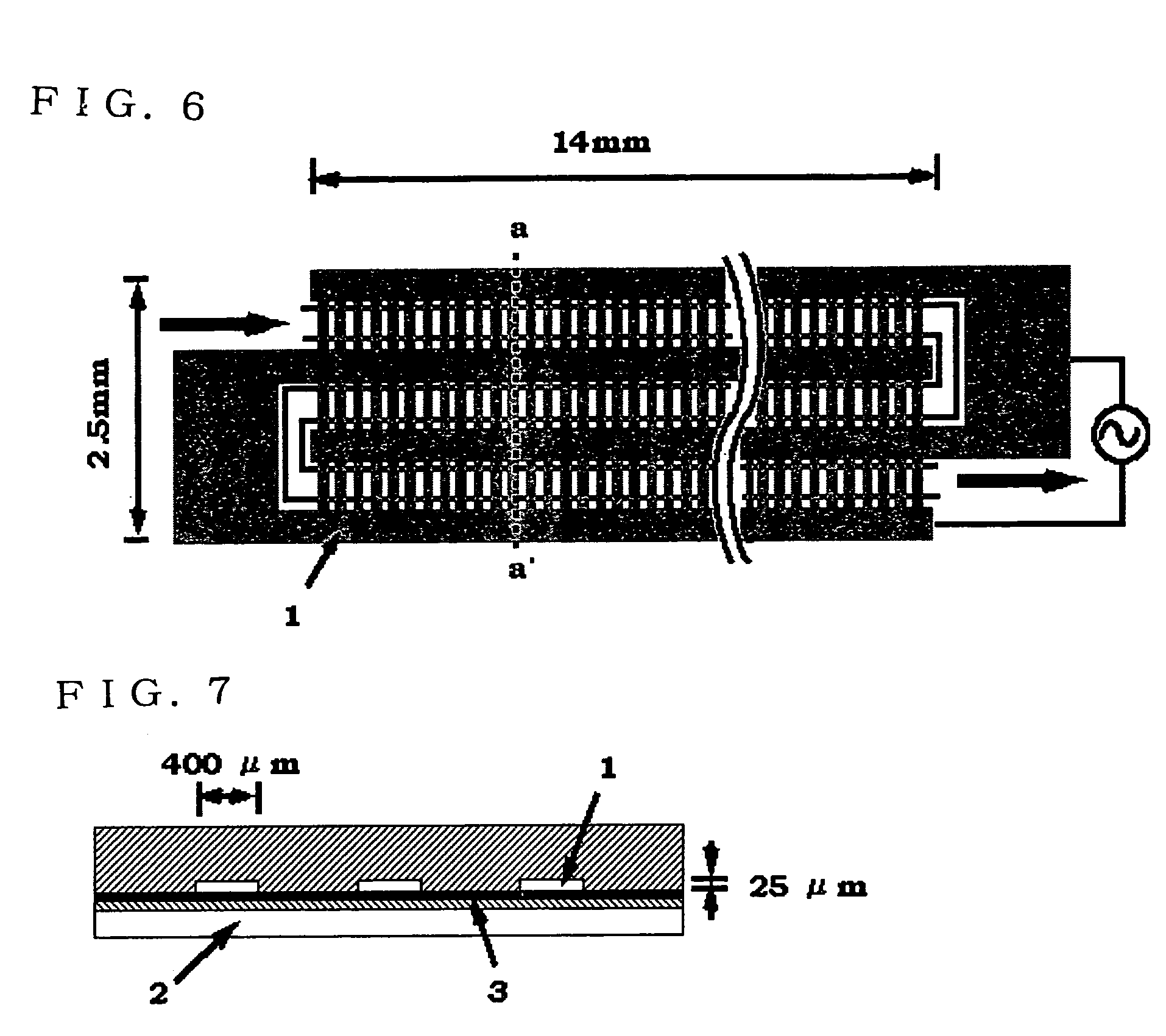Method for separating substances using dielectrophoretic forces
a dielectrophoretic force and dielectrophoretic technology, applied in electrostatic separators, diaphragms, electrolysis, etc., can solve the problems of high throughput of separation processing, low detection sensitivity, and high voltage of electrotrophoretic methods, so as to achieve rapid and convenient separation of respective molecules
- Summary
- Abstract
- Description
- Claims
- Application Information
AI Technical Summary
Benefits of technology
Problems solved by technology
Method used
Image
Examples
reference example 1
Manufacture of Dielectrophoretic Electrode Substrate
[0168]A multi-electrode array having a minimum gap of 7 μm, an electrode pitch of 20 μm, and the number of electrodes of 2016 (1008 pairs) was designed, and a photomask according to the design was made for manufacturing the electrode as follows.
[0169]On a glass substrate on which aluminum was deposited and to which a photoresist was applied, an electrode pattern as designed was drawn on an electron beam drawing machine, and then the photoresist was developed and the aluminum was etched to make the photomask.
[0170]The electrode substrate was manufactured according to the method described in T. Hashimoto, “Illustrative Photofabrication”, Sogo-denshi Publication (1985), as follows.
[0171]The photomask thus made was contacted tightly with the aluminum-deposited glass substrate to which a photoresist was applied, and then exposed to the electrode pattern with a mercury lamp. The electrode substrate was manufactured by developing the expo...
reference example 2
Manufacturing an Electrode Substrate Having a Flow Path
[0173]In order to separate molecules by the movement of the molecules under an nonuniform AC electric field, a flow path on the electrode substrate manufactured in Reference Example 1 was made using silicone rubber.
[0174]The silicone-rubber flow path for sending a molecule dissolving solution on the electrode had a depth of 25 μm and a width of 400 μm and was designed such that the flow path runs through a region in which the electrode on the electrode substrate was placed.
[0175]Its manufacturing was carried out according to the method described in T. Hashimoto, “Illustrative Photofabrication”, Sogo-denshi Publication (1985). At first, a sheet-type negative photoresist having a thickness of 25 μm was applied onto the glass substrate, exposed with a photomask designed for making the flow path, and the negative photoresist was developed. Uncured silicone rubber was cast using the negative-photoresist substrate as a template, and t...
example 1
Detection of Biotin Molecules with a Dielectrophoretic Chromatography Apparatus (Field-Flow Fractionation Apparatus)
[0178]Biotin was bound to λDNA as a separation improving substance of dielectrophoresis to give biotinylated λDNA, which was then mixed with a fluorescein-labeled anti-biotin antibody to carry out the antigen-antibody reaction with the use of the resultant as a sample, quantitative detection of biotin molecules was carried out with a dielectrophoretic chromatography apparatus.
(Reagents)
[0179]The biotinylated λDNA in which biotin was coupled with λDNA was prepared using Photo-Biotin Labeling Kit (Nippon Gene Co. Ltd.) according to the appended preparing protocol. The components were then mixed at ratios as shown in Table 1 in 50 mM PBS (pH 7.5) to carry out the antigen-antibody reaction. The concentration of total λDNA in each sample was adjusted to 0.32 nM by adding non-biotinylated λDNA, which is equal to the concentration of the biotinylated λDNA in the sample having...
PUM
| Property | Measurement | Unit |
|---|---|---|
| electric field strength | aaaaa | aaaaa |
| electric field strength | aaaaa | aaaaa |
| frequency | aaaaa | aaaaa |
Abstract
Description
Claims
Application Information
 Login to View More
Login to View More - R&D
- Intellectual Property
- Life Sciences
- Materials
- Tech Scout
- Unparalleled Data Quality
- Higher Quality Content
- 60% Fewer Hallucinations
Browse by: Latest US Patents, China's latest patents, Technical Efficacy Thesaurus, Application Domain, Technology Topic, Popular Technical Reports.
© 2025 PatSnap. All rights reserved.Legal|Privacy policy|Modern Slavery Act Transparency Statement|Sitemap|About US| Contact US: help@patsnap.com



